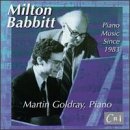| All Artists: Goldray Title: Babbitt: Piano Music Since 1983 Members Wishing: 0 Total Copies: 0 Label: Composers Recordings Release Date: 5/20/1997 Album Type: Import Genres: Special Interest, Classical Style: Number of Discs: 1 SwapaCD Credits: 1 UPC: 090438074629 |
Search - Goldray :: Babbitt: Piano Music Since 1983
 | Goldray Babbitt: Piano Music Since 1983 Genres: Special Interest, Classical
|
Larger Image |
CD Details |
CD ReviewsLet this music engage you. Beautiful or not, it may hook you Frank Camm | Northern Virginia | 12/10/2004 (5 out of 5 stars) "It is hard to disagree that beauty is in the ear of the listener or that not all art is about beauty. Either way, this music is not for everyone. I for one happen to love it and want to get to know it better. I do not read scores as I listen or know enough about music theory to distinguish one form of serialism from another. But when I *listen* to this music, it grabs my attention--demands it--and engages me. I like what I hear; it sounds something like this: Canonical Form (1983): First, rumbling. Then scurrying in short bursts, forming a foamy kind of glowing, neon effervescence in a black sea. A series of island-like, long bundles of such effervescence with differing colors or forms of lights-I see a bundle of lights, brief blackness, another bundle, blackness, etc. Each island is clearly meant to be experienced as a separate movement or section within the piece. Intense, fine, spare beauty. A kind of Zen simplicity seems to emerge from these complex sets of brilliant dots of light. Emblems (1989): Subtly different. A bit sharper, edgier, more demonstrative. More fidgety; less foamy display of lighted collectives of notes. Events feel more isolated from one another, harsher. As in "Canonical Form," this comprises more texture than line or harmony. Where "Form" had the feel of a filmy texture, this is more like a series of rips or tears in an underlying texture. But through the course of the piece, the edges of events tend to become softer. Events seem to grow closer to one another and, slowly, seem to run into one another more and more, creating ever longer segments of running notes. Such change is imperceptible at any point in the piece. Preludes, Interludes, and Poslude (1991): Mischievous, coquettish, teasing. Sparkling needle pricks with warm, glowing auras around them. Spare, but overall, the music is more bright than dark. Energized, but without apparent movement or development. Crystalline, funkless jazz; very pure, as though concentrated. Tutte le Corde(1994): Cells of timbre-color juxtaposed vertically and horizontally. Each cell is a flash of sound, a few notes in a brief, cool/quick or warmer/steady sequence. Spare, but total silence never occurs; resonances of one cell replace those of the cell before. No apparent movement or development. Overall effect is one of intense activity in silence, of heat surrounded by so much cool that you see the heat, but never feel it. Maybe Kandinsky felt this way when he was trying to explain how his mid-career abstractions were simply visual analogs of the ultimate abstract art--music. This may not be everyone's cup of tea. But however Babbitt achieves these effects, I'll be back to get more. I'm hooked. Solo piano seems an ideal medium in which to experience them." A brilliant performance of stunningly beautiful music Frank Camm | 05/22/1999 (5 out of 5 stars) "Works on this recording are some of the finest of his output for solo piano. These piano pieces are virtuosic and elegant in form and expression, intelligent and emotive on a very high level." Active listeners: Attention, please! Joe Canoe | 10/15/2004 (5 out of 5 stars) "This lovely disc is both a great place to start if you're new to Babbitt's music and the best all-Babbitt piano disc. Babbitt's music is quirky, unusual, and, at times, breathtakingly beautiful like no other I know. I prefer Goldray's more sensual playing to Alan Feinberg's steeliness and certainly to Robert Taub's wild inaccuracies. Very highly recommended."
|

 Track Listings (4) - Disc #1
Track Listings (4) - Disc #1